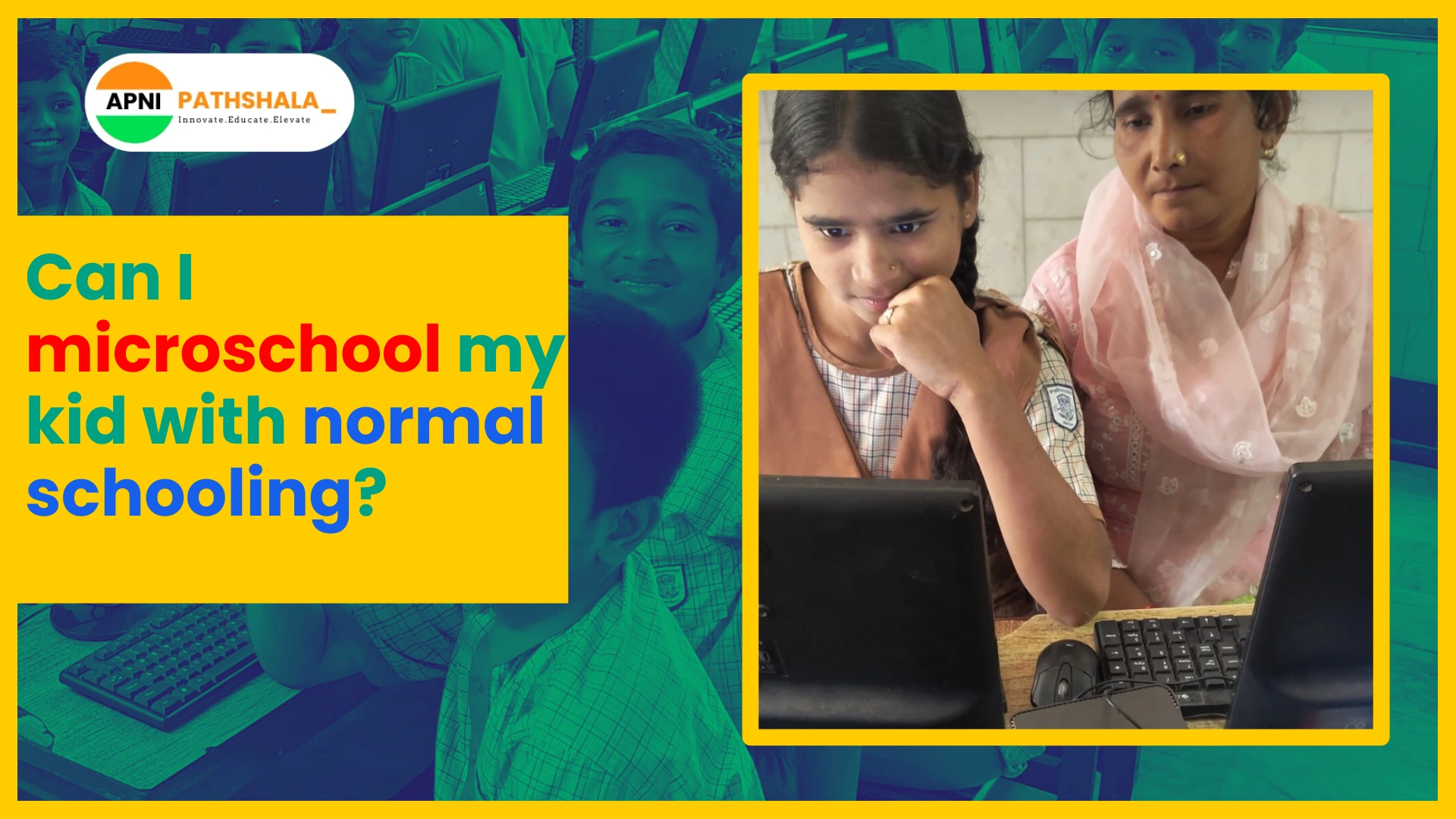Let’s get straight to it: Yes, you can microschool your child even if they go to regular school.
Microschooling doesn’t mean you have to pull your child out of school. It simply means adding purposeful, interest-based learning into their life outside school hours. Think of it as upgrading your child’s education without disturbing their school routine.
Now that we’ve cleared that up, let’s understand how it works.
What Is Microschooling?
Microschooling isn’t some fancy trend. It’s just small, focused learning done in a more personal, interest-driven way.
- It can happen at home, in a community group, online, or offline.
- It’s flexible: 1 hour a day or 3 hours a week. No pressure.
- It’s about what your child wants to learn: robotics, art, mental math, writing, nature walks, or whatever sparks curiosity.
The best part? You don’t have to follow a textbook. You follow your child’s interests.
Why Combine Microschooling With School?
Because let’s be honest: school alone often isn’t enough.
Your child might be doing okay in school, but is that all you want for them? Just okay?
The truth is:
- Too rigid: One-size-fits-all teaching can miss your child’s unique spark.
- Too exam-focused: Marks matter, but what about real understanding?
- No room for creativity: Schools rarely allow time for kids to explore their passions.
- Minimal flexibility: If your child wants to dive deep into something they love, robotics, storytelling, design, or music, school just doesn’t offer the space.
That’s where microschooling with regular school steps in.
Think of it as giving your child a second lane to drive on, where they get to explore, question, create, and fall in love with learning.
It’s not about quitting school. It’s about complementing school with something richer, more personal, and joy-filled.
Microschooling allows your child to learn things school doesn’t teach, like critical thinking, real-world problem-solving, emotional intelligence, entrepreneurship, or even urban farming.
And no, it doesn’t clash with school. It blends with it. In fact, many parents ask, “Can I microschool my child even if they attend regular school?” The answer is a loud yes!
Microschooling is flexible. It fits around your child’s school hours, energy, and interests.
It works with the system, not against it.
What Microschooling Looks Like Alongside Regular School?
You might be thinking: Okay, but how do I actually do this?
Let’s say your child goes to school from 8 AM to 2 PM. That still leaves evenings and weekends wide open. That’s your microschooling space.
It doesn’t need to be complicated, expensive, or full of pressure. Here’s what a typical week of microschooling alongside normal school might look like:
Weekdays (4 PM – 5 PM): After school, your child joins a storytelling or robotics session from home. This could be through online platforms or even a passionate neighbour teaching coding to a small group of kids.
Fridays (6 PM – 7 PM): A relaxed community circle where kids read stories aloud, ask “Why?” questions, or brainstorm startup ideas. No marks, no lectures: just curiosity.
Saturdays: Your child joins a group of 3-4 kids from your neighbourhood to explore DIY science projects, design thinking games, or even local history walks.
Sundays: Family-led outdoor learning: gardening, nature trails, bird-watching, or simple engineering challenges like building a bamboo bridge or a water filter at home.
All of this is microschooling. No whiteboards, no uniforms. Just kids learning like they were meant to by doing, playing, failing, and trying again.
And the best part? You don’t need fancy tools.
Even free, trusted platforms like:
- ApniPathshala – for Indian learners who want to get educated on homeschooling, learning pods, microschooling, etc.
- Khan Academy – for self-paced academic content
- YouTube – free content for various
- BeyondExams – for free intro courses on various skills
That’s all you need to get started with microschooling alongside traditional school. You’re not pulling your kid out of the system. You’re just giving them wings outside it.
How to Get Started? (Even If You’ve Never Done This Before)
First things first: Don’t overthink it. You don’t need to be an expert. You don’t need to be a trained educator, a homeschooling guru, or someone with lots of time and money.
If you’re asking, “Can I microschool my child even if I work or have no teaching experience?” — the answer is yes. Microschooling with regular school is all about small steps that create big shifts.
Here’s how to get started, even if you’ve never done this before:
1. Ask your child what excites them outside of school.
What do they talk about when they’re free? What do they do when no one’s watching?
- Is it drawing, building Lego towers, writing stories, or asking “Why” questions?
- Maybe they love watching nature videos, designing rooms in Minecraft, or fixing broken toys?
That’s your starting point.
2. Pick one topic. Just one.
Don’t try to do everything at once. Microschooling doesn’t mean creating a second school at home. It means giving your child a little extra space to learn what lights them up.
So, pick one area of interest and go from there. For example:
- Robotics
- Public speaking
- Wildlife and nature
- Digital art
- Gardening
- Inventing things
3. Schedule just one small session a week.
Start with something like: Every Saturday, 11 AM – 12 PM = Curiosity Hour. That’s it. No pressure. No marks. Just learning for the joy of it.
4. Find a simple resource:
You don’t need to buy expensive kits or enroll in costly courses. There are tons of free or low-cost options to begin microschooling alongside normal school. We’ve already discussed online resources, let’s know about offline ones now.
- Offline Options
- Form or join a small micro-group in your building or society.
- Get 2–3 kids together every Sunday for a nature walk or book club.
- Ask local mentors or artists if they’d love to guide a few kids on weekends.
5. Focus on consistency, not intensity.
It’s not about teaching for 10 hours a week. It’s about showing up for 1 hour regularly. That consistency builds confidence for you and your child. Microschooling with regular school is not a race. It’s a rhythm.
6. The goal? Not pressure. Curiosity.
You’re not doing this to make your child an IIT topper or a genius entrepreneur overnight. You’re doing it so they remember what real learning feels like.
Curious, alive, full of “wow!” moments.
Common Myths (And the Real Truths)
Let’s bust a few doubts that hold most parents back from microschooling their kids alongside regular school.
Myth 1: I need to quit my job to do this.
Truth: Nope. You can start with just 1–2 hours a week after school. That’s enough to begin with and many working parents are already doing it.
Myth 2: I need special training.
Truth: You don’t need a B.Ed. If you can listen to your child, ask questions, and create time for exploration, you’re already more than qualified.
Myth 3: This will confuse my child.
Truth: It’ll actually help them. Kids often learn better when they can connect school subjects with real-world learning. Microschooling bridges that gap beautifully.
Myth 4: My child won’t take it seriously.
Truth: They will, if they’re excited about it. When kids get to explore what they love, they show up differently. With energy. With curiosity. With ownership.
Final Thoughts: A Better Way to Learn Starts at Home
Microschooling doesn’t compete with school. It completes it. It adds the missing puzzle pieces that traditional education often skips.
In a world where kids are growing up with questions that schools don’t always answer, What’s my purpose? Why does this matter? How do I solve real problems?We can’t afford to wait.
Microschooling gives kids the space to explore those answers. And the best part? You don’t need to overhaul your life or throw away the school calendar. Just start. Small. Weekly. Personal.
And if you ever feel stuck, confused, or overwhelmed, you’re not alone.
Visit ApniPathshala to explore expert guidance and real stories from Indian families doing this every day.
Your child deserves more than just school. They deserve a life full of learning.

